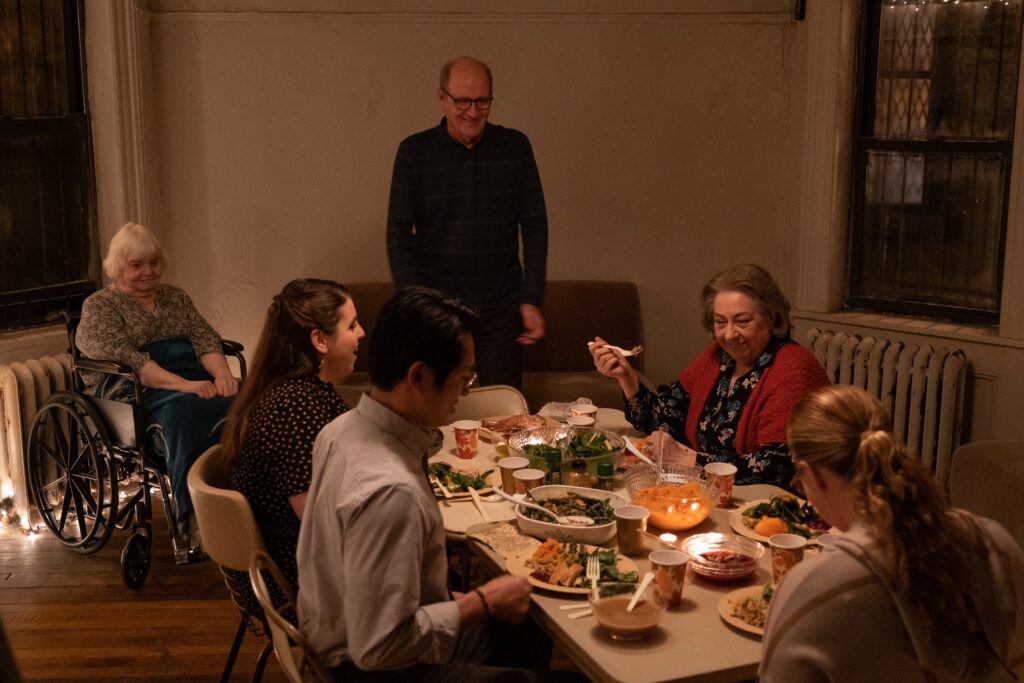
The Thanksgiving holiday can be a time for reflection, spending time with your family, thinking about the past year and what is to come ahead. It is also a time for movies, from big action films to small awards contenders. Only one feature film this year, The Humans, actually portrays a family coming together for the Thanksgiving holiday in New York City, however that simple premise involves a lot more than it would lead you to believe. After premiering at the 2021 Toronto International Film Festival (TIFF) and making the rounds of the festival circuit to critical raves and positive audience response, the film is currently in select theaters while also simultaneously streaming on Showtime.
The film’s writer and director, Stephen Karam also happens to be one of my favorite playwrights. Ever since I first saw his play Sons of The Prophets in 2011, I have tried to see as much of his stage work as possible. Now, ten years on, Karam has adapted his own play, which was a finalist for the 2016 Pulitzer For Drama and had runs Off-Broadway on Broadway and in London, into a movie. It is also the second play of his that he has adapted for the screen after his breakout work, Speech & Debate, was released as a film in 2017. Karam comes to this piece as a first-time director.
When I was offered the chance to sit down and talk to him in person at the beautiful Park Lane Hotel just off Central Park about one of my most anticipated films of the year, I jumped at the chance. You can read Below the Line’s interview below, which has been condensed and edited for clarity.
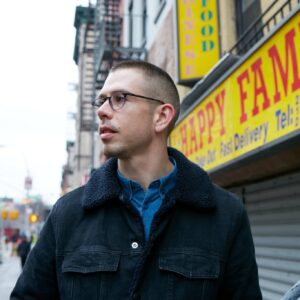
Below the Line: I think I have a unique perspective, because I was at the first off-Broadway preview, and I also sold merchandise at the show through its Broadway run.
Stephen Karam: I remember your face very well, and you remember those encounters, because those moments are also so heightened. There’s just no crazier time, at least for me, than the preview period and the rehearsal, so I remember everybody at Roundabout [Theatre Company]. I remember the people who poured a glass of red wine to get me through the previews and sitting in the last row. I remember all the ushers, because it’s kind of this intense moment, and it isn’t for anyone. Everyone else is just like selling merchandise, the playwrights walking around thinking, “Does the story work? Did I spend four years making something that even works?”
BTL: I looked it up last night — the first preview was like six years ago already.
Karam: And when you think that it was in Chicago before.
BTL: You have been living with this play on stage for seven years now. Now it’s going to be on a screen for pretty much everyone in the world to see. How does that feel to you?
Karam: I guess it feels good. I was talking to Jane [Houdyshell, part of the cast that appeared on stage and in the film]. I think one of the things I have a real gratitude about and appreciation for is that I can have this conversation with you, that you saw it so many years ago, and that there’s something about a story, not just my story, but when a story about a family or group of people is told in a way that captures a certain kind of essence or truth that if you’re lucky, it can continue to exist, even as the world changes around it, or as people’s lives shift and change their view of the story changes.
It’s been a real joy to see that it doesn’t somehow crumble. I think the fear when you make something is that, is it just of the moment? I’m glad nobody’s talking about tweets and Hillary Clinton throughout the play, but if I tried to make something and tried to predict what could have an existence that lasts like seven, eight, nine years, I don’t think I would have done it. I just feel grateful that these six people are in this enclosed space, where it just seems to be a world outside them. I mean, even the metaphor of this very real moment in their lives. I always think of the play being deep, so real and also kind of an abstract play at the same time, but I feel there’s even something to the physical element of it being important that the world outside is voided or even in a very big film that can go anywhere. Somehow, you don’t really see other people even in a place like New York City, like the camera’s now in New York City, and you just don’t become preoccupied with other human beings, even in a city with millions of people.
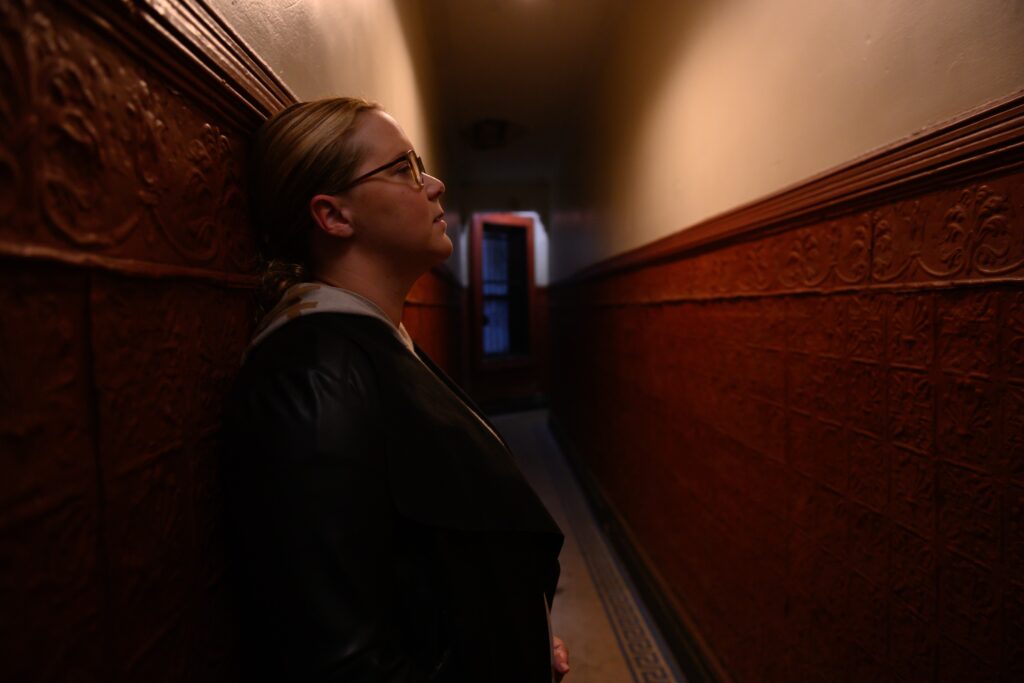
BTL: That’s a good jumping-off point for the film’s visual setup. It felt like I was watching elements of the play that were heightened by being more intimate than when it was on stage. Was that a real apartment, or was that a set that you guys built on a stage?
Karam: It is 80% or 90% filmed on a sound stage. It is a built set based on real prewar apartments, specifically I lived in a ground floor basement apartment for years. But [Production Designer] David Grossman was a crazy genius. Once he realized I was going to be in the space as a voyeur and the space would have a certain kind of presence and power and I’d be filming up close, that’s when there was no cheating. The molding, the layers of paint… the doors we’re actually over 100 years old, as were the hinges, meaning the attempt to bring old things into a new build. So, for authenticity’s sake, and even the dimensions, pre-ADA Act, those hallways I wanted the real deal because I lived in those tenements. And then that blood-red hallway that Amy [Schumer] character can barely make it down with June Squibb those are all real spaces in the Lower East Side – Chinatown.
BTL: Was that shot in the building you had lived in?
Karam: No, but adjacent to, yeah, and In the overture to the movie — I call it the overture you can tell from the theater. In the overture to the movie, the opening air shaft is my New York City air shaft.
BTL: You know what they say — use what you know.
Karam: Right and it’s surprising, as a first-time filmmaker, to just take that even with my iPhone, filming those as tests, with our incredible cinematographer and sending them to him, even in terms of just trusting your gut, there should be an overture of sky shapes. And that’s the way to enter this world. But when it literally becomes your airshaft opening a film, you have to kind of laugh at that, the thing that you’ve stared at, in a much less flattering way with cigarette butts for years suddenly becomes beautiful. That, to me, feels like the right metaphor for the whole enterprise.
BTL: Am I right to guess that most of the film is just using natural existing lighting? Pretty much like anything that would be in the apartment is essentially lighting the shots?
Karam: We used lots of practical lighting. The beauty of working with [Cinematographer] Lol [Crawley] was I just fell in love with so many movies that were just so gorgeous and confidently dark, like a lot of movies from the ‘70s and ‘80s. Gordon Willis has some cinematography which is famously dark, but also famously vibrant, and he ran towards that. So thinking about even when the lights that do exist within the apartment started to go out, this sort of care and prep that needed to go into pre-production so that to still achieve that and not look like we then started to put ring lights on everybody’s faces. It was a real, measured quality, so that the wind at the light filtering in even from neighboring apartments, would it be sufficient? Would it not? And the glorious things about those in even my current air shaft is that, I’m about two feet away from my neighbors on one side of my apartment and your lighting at night changes based on whether they turn their light on, and their artificial light starts to come into your space. And so playing with all of those tools was amazing, and Lol is really extraordinary with light.
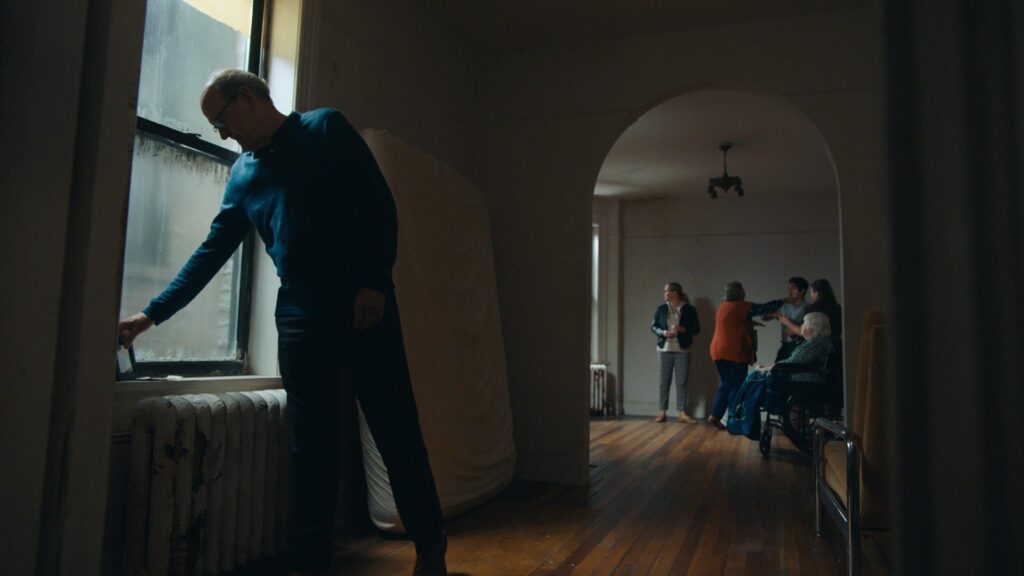
BTL: I’m thinking specifically of when Erik [Richard Jenkins] is standing at the window looking at his phone and you kind of can see the light coming in from someone else’s apartment. The play on stage never leaves the apartment or the building, however in the film we actually get to go up on the roof with some of the characters. Can you talk a little bit about that moment? It’s an amazing shot. [Note: Minor spoilers in response]
Karam: It’s just one of those things that with the limited days and lower budget when they happen you just can’t believe it, like there were just the most glorious cloud shapes. Everything that feels like a special effect in the film, including when we went into Eric’s beer aren’t actually special effects. Everyone was saying you can’t put the camera that close. We put the camera that close, and we were like Christmas lights through a beer that actually looks fascinating because you get lost. It feels like we’re in Dune for a minute, and we’re lost on another planet.
The roof, specifically, it was again the emotional thinking about always trying to be weirdly faithful to the story and the effect of the play led to all the things that feel very different in the new medium and one of them was that the explosion of June Squibb’s character, the fit of rage that she has and confusion that always feels like it’s almost an explosion of everything that can’t quite be said by the family, this manifestation of all the pent-up tension, when it died down on camera I kept thinking about the other characters and when Brigid [Beanie Feldstein] leaves the apartment. Basically, the idea of what could that explosion be when you have a little more access and still feel very chained to the apartment? What would that be? Where do I go when I feel deeply suffocated by my space is my roof? Because I don’t have any views, but I do have a view on the roof. I thought about the idea of even running up the stairs, and what would be the sort of visual continuation of this ratcheting up of everything? And that led to also thinking about the function of the pillow shots that you see from the beginning, the snippets of the apartment and glimpses that the characters, but mostly Richard Jenkins’ character, sort of seeing the things he’s clocking.
So then, that combined with what was happening from the opening moments, sonically the sounds of the apartment, so the radiator planks take you through the pillow shots into the buzz from the lights, and the sound of the neon. Somehow you put images together with the soundscape coming to a head and the most exciting part of it isn’t just the emotional relief and feeling like you almost feel Beanie and Steven Yeun feel when they run up to the roof to get a breath of fresh air. But you, as an audience member, almost feel it, too, because you have been locked in that apartment, too. It’s also one of the few times [Composer] Nico Muhly’s doing a music cue that gets to sound like it emerges from the huge vent on the roof. It’s connected to all the sounds you’ve been hearing from the moment Eric is tracing conduit wire and the clanks from the heating systems, so it felt like a kind of catharsis and explosive moment that the audience maybe just gets to experience without any conscious thought. But hopefully for a viewer, it’s a rush of something inevitable and necessary.
BTL: Do you know that Twitter account, One Perfect Shot? They post the essential shot from any given film and talk about it. To me, that shot on the roof with the sun coming behind the buildings would be the shot they pick
Karam: It’s one of those things where you also start to feel the reverberations of the decision to blur the focus at the end of that shot. We did that in-camera, which is a big deal, in that you can’t go back, but I always wanted to tie it to the next thing being Jane’s character talking about that email about us being electrons, because it sort of plays with the biggest thing that you see, which is the city, being sort of blurred to a series of glow balls. This idea of molecules and particles that’s played with throughout the film, like being very close, so that the family is almost a series of light shifts. This idea that you’re hearing one small story about one family, but somehow even in this confined space, you’re also thinking about, the impossible expanse of a city of the world of the universe. I love stories that do that, where it’s, really about this person. And somehow you’re also thinking about bigger things at the same time, which is why it was fun to be very close and very far and see what that felt like.
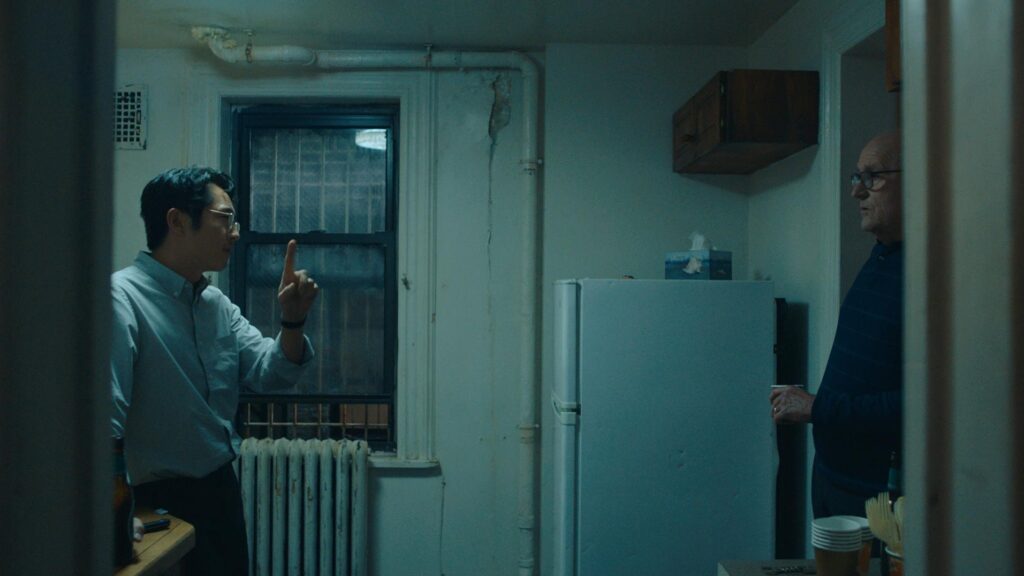
BTL: I’ve always had a theory about something happening outside of the play. At one point, Steven Yeun’s character, Richard, is talking about a comic book that he likes, and how these creatures sit around and tell stories about “the humans”. The piece is called The Humans, so is what we are watching a story that these creatures are telling each other?
Karam: I feel like while I can’t say “yes,” specifically, it was conceived by like no one could conjure what entertainment would be to another species of creatures. But I did kind of love the idea of what if our idea of horror to another group of creatures that we couldn’t possibly imagine was something as ordinary as a family having Thanksgiving. I kind of always viewed it through that lens without the importance or the specificity for people to literally know that or take it away or think of it that literally, I’m the type of writer that when I need somebody to really indisputably understand something, it’s in there in the text, so that people don’t miss it. And then the things that seem to be ambiguous. I think it’s the kind of experience I love, which is where someone like you is like, “Hmm, I wonder who is watching a mother and a daughter be passive-aggressive with each other? Or a daughter trying to deal with being a lesbian and heartbreak? Is that like their equivalent of gore or a slasher film?”
BTL: I’ve wanted to ask you that for years. I’m just glad you didn’t say, “I have no clue what you’re talking about.”
Karam: No, I do know what you’re talking about. I’m actually surprised more people haven’t asked that.
MAJOR SPOILERS ABOUT THE END OF THE HUMANS IN THE NEXT QUESTION AND RESPONSE
BTL: When the piece is presented on stage, the set is a bisected two-level home. In the film, you don’t see that represented, except for the very end of the movie looks like it was done onstage, as if a camera has somehow pulled out and you’re seeing it on a stage. Why does that specific moment look the way that it does?
Karam: It’s the only moment that when I thought about the truth of that moment. It’s like the perfect sample of something that feels, somehow, the most connected to the play, and at the same time, I also think of it as having a totally new feeling. The idea of being able to be at the table with him and then do the pullback into the mis-en-scène that you’re talking about creates a sense of expanse into the sort of cosmos of the titles in a way that you’re always seeing everything on stage. So you always have a sense of the expanse, as opposed to being able to be at the table.
Why did I choose that? I have always included it, even when we were first in Chicago and she comes in upstairs. It was always so that moment of the story didn’t feel like it was on the daughter. It was almost the reason the whole play was like a dollhouse leading up to that moment. Something about that moment of forgiveness was about the distance between them, but also being able to be with both of them at the same time. And the kind of hope that comes with a kind of, hey, I love you, that can’t actually be said as I love you. I don’t think that moment could happen 10-feet apart on the same level.
And so visually, I kind of just went for it, even though it felt so theatrical, because it also felt like the most interesting kind of reveal one could do cinematically, even though it is the most theatrical. It again takes you from something that is a total surprise, you don’t at that point even know that it is a build, let alone a by-level like that you’d even have the facility to remove a wall. And again, the entire film in a way that maybe people do or don’t clock plays with being close, being far and shots that go from being far too close. In the end, the first time being with him at the table and his panic attack. And sort of the opposite of the other dolly shots, almost pulling back into something that felt in cinema to me feels impossible. Whereas you accept it from the moment you walk into a Broadway theater. In cinema that moment, especially for people who haven’t seen the play, almost feels like the most cinematic, like the Star Wars moment of the thing. I kind of love that combination. I mean, it feels very truthful to what I hoped to do, which was not to run away from the heart and the soul of the things that are special about it being only theatrical and also sort of not running away from anything that felt right in adapting it as a film
BTL: Well, I could talk to you all day about this, but our time is up, I just want to say thanks again for taking the time to talk
Karam: I can’t believe we’ve had this journey together.
The Humans is now playing in select theaters, and it’s also available to stream on Showtime.
All photos courtesy A24.





